The Psychology of Social Media: Why We Like, Comment, and Share Online

Former Director of People @ Buffer
What would happen if you were to “like” everything you saw on social media?
The developer Rameet Chawla found out when he built a script that liked every photo that passed through his Instagram feed.
- He grew his followers by about 30 a day
- He got invited to more parties
- He got stopped on the street by people who recognized him from Instagram
- He got message after message from friends encouraging him to post more. He said it was “almost like they were frustrated, like they were longing for something to like in return.”
The likes, comments and posts we share on social media can often seem inconsequential, but they matter. They tap into some of the very elements that make us human, our addictions, desires, anxieties and joys.
Try Buffer for free
140,000+ small businesses like yours use Buffer to build their brand on social media every month
Get started nowWhat if we could understand the psychology of social media and use that knowledge to bring customers closer, give them more of what they want, and create better relationships?
I had the supreme privilege of talking about just that topic at Mozcon, a super fun and crazy informative marketing conference put on by our friends at Moz. I’m excited to share the highlights with you!
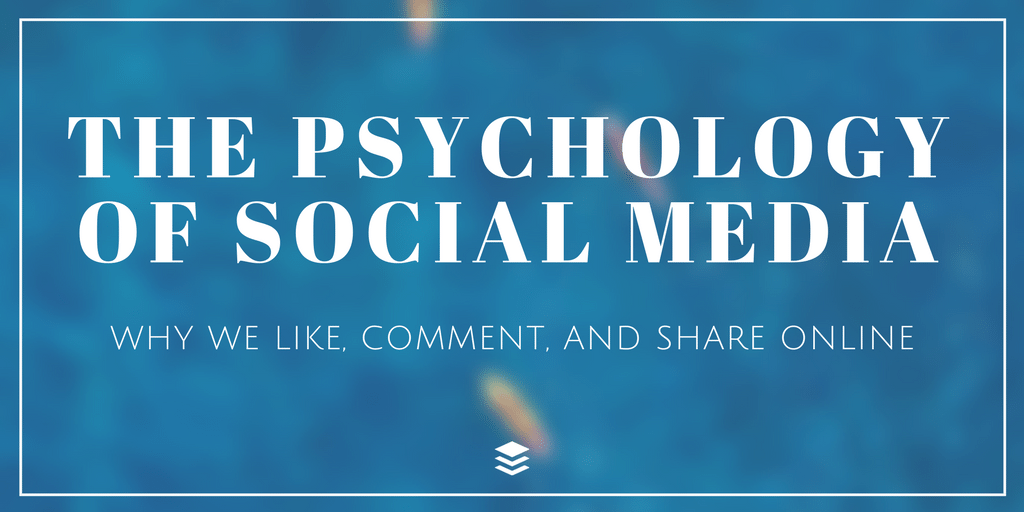
Social media biology: Dopamine and oxytocin
The pull of social media addiction isn’t all in our heads. It’s quite real, thanks to two chemicals our brains produce: dopamine and oxytocin.
Dopamine

Scientists used to think dopamine was a pleasure chemical in the brain, but now we know what it actually creates is want. Dopamine causes us to seek, desire, and search.
Dopamine is stimulated by unpredictability, by small bits of information, and by reward cues—pretty much the exact conditions of social media.
The pull of dopamine is so strong that studies have shown tweeting is harder for people to resist than cigarettes and alcohol.
Oxytocin
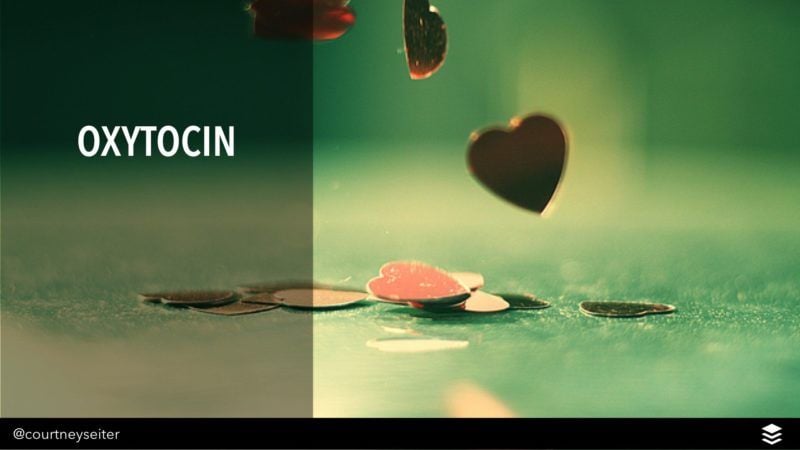
Then there’s oxytocin, sometimes referred to as “the cuddle chemical” because it’s released when you kiss or hug.
Or … tweet. In 10 minutes of social media time, oxytocin levels can rise as much as 13%—a hormonal spike equivalent to some people on their wedding day.
And all the goodwill that comes with oxytocin—lowered stress levels, feelings of love, trust, empathy, generosity—comes with social media, too.
As a result, social media users have shown to be more trusting than the average Internet user. The typical Facebook user is 43% more likely than other Internet users to feel that most people can be trusted.
So between dopamine and oxytocin, social networking not only comes with a lot of great feelings, it’s also really hard to stop wanting more of it.
Social media actions: Why we post, share, like and comment
Next, let’s look at some of the major activities we do online and find out what psychological strings are being pulled with each of them.
Why we post on social media
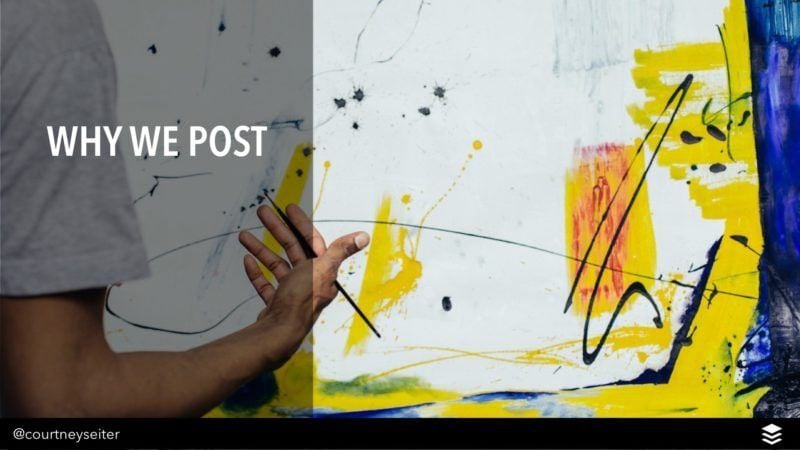
It’s not news that we love to talk about ourselves.
Humans devote about 30–40% of all speech to talking about themselves. But online that number jumps to about 80% of social media posts. That’s a huge jump!
Why? Talking face-to-face is messy and emotionally involved–we don’t have time to think about what to say, we have to read facial cues and body language.
Online, we have time to construct and refine. This is what psychologists call self-presentation: positioning yourself the way you want to be seen.
The feeling we get from self-presentation is so strong that viewing your own Facebook profile has been shown to increase your self-esteem.
What’s also interesting for marketers is that the most prominent way we tend to work on self- presentation is through things—buying things and acquiring things that signify who we are.

Think: Clothes, games, music, the logo on your laptop right now.
The intensity of emotion people can feel for their favorite brands as a result of this is incredible. An experiment showed volunteers two types of photos: the logo for a brand they loved and pictures of their partners and closest friends.
Their physiological arousal to the logo was as intense as the arousal of looking at a picture of their closest friend.
Things—and by extension, brands—are a huge part of who we are.
What I take away from this is to work really hard to figure out what is aspirational about my brand that my customers can identify with.
Brands that can create aspirational ways for their community to interact with them not only create social media opportunities but also the chance to move beyond likes into something lasting.
Why we share on social media
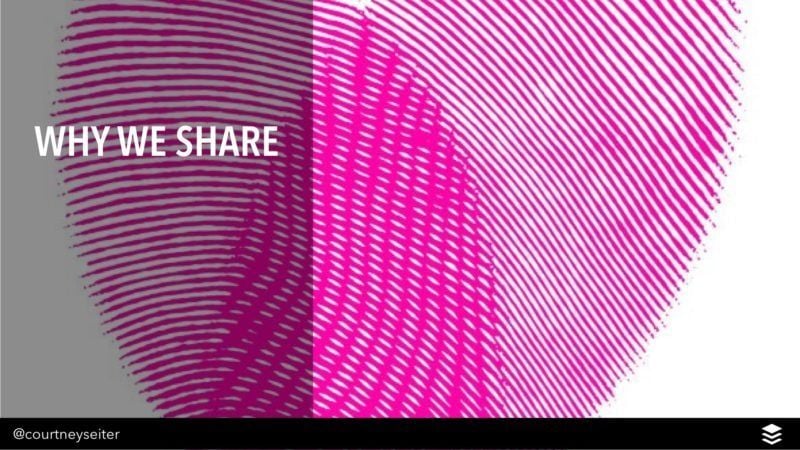
If we like talking about ourselves so much, what would make us share something of someone else’s?
Passing information on is an impulse that we’re hard-wired with. Just the thought of sharing activates our brain’s reward centers, even before we’ve done a thing.
Self-presentation, strengthening relationships
First, it comes back to our own self image: 68% of people say they share to give others a better sense of who they are and what they care about.
But the biggest reason we share is about other people: 78% of people say they share because it helps them to stay connected to people.
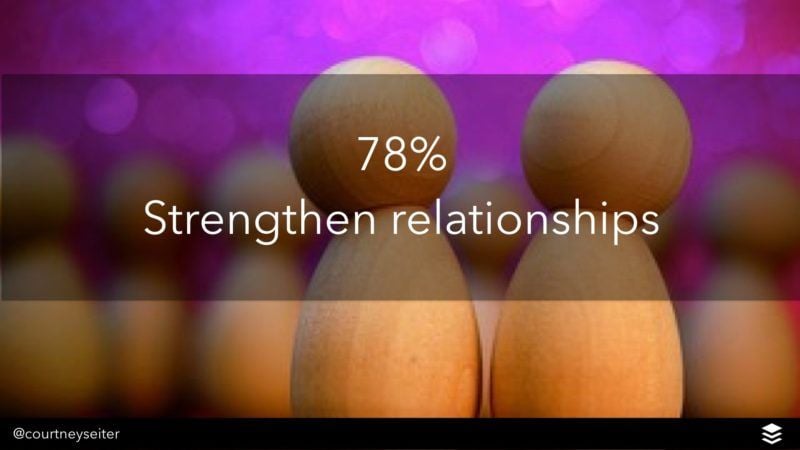
Experiments have shown that the best predictors of contagious ideas in the brain are associated with the parts that focus on thoughts about other people.
This means content designed for social media doesn’t need to appeal to a large group or an average group. it just needs to appeal to a specific person.
Social currency
And when we share the right type of content, we gain social currency—our stock goes up. 62% of people say they feel better about themselves when people react positively to what they post on social media.
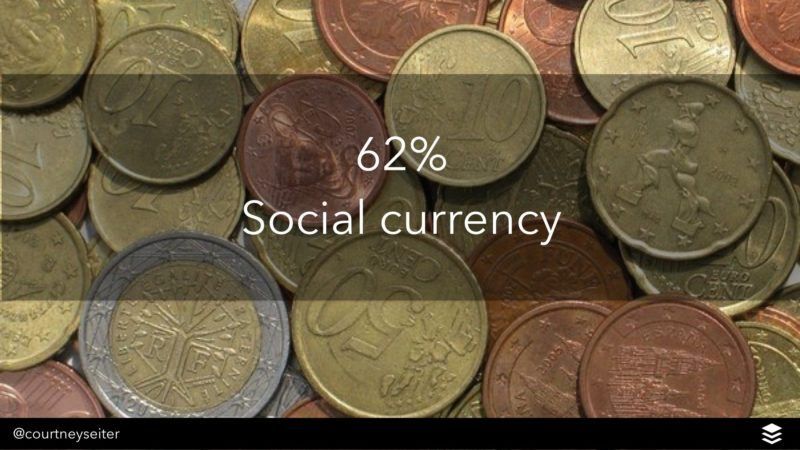
How can brands create social media currency? By having something interesting to say.
Jeff Goins wrote on our blog about this little-known research paper from the 1970s that attempts to create a unified theory of what makes something interesting.
The author, Murray Davis, says all interesting content is “an attack on the taken-for-granted world of their audience.”
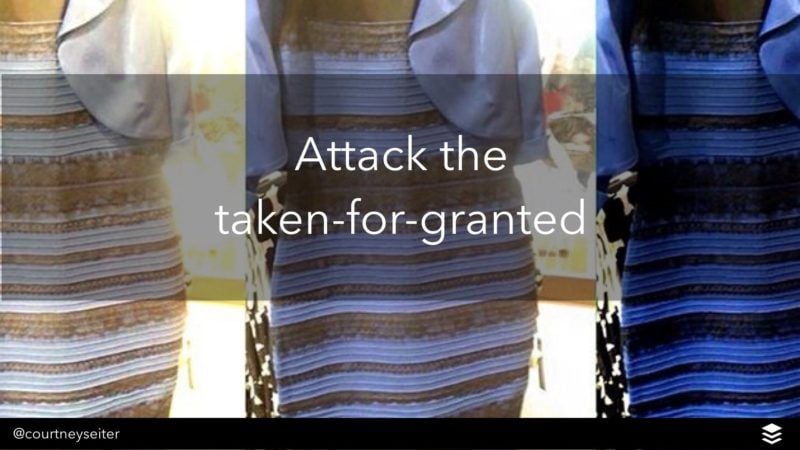
Like “the dress,” things that are interesting deny our assumptions in some way; they shake us up.
Why we like on social media
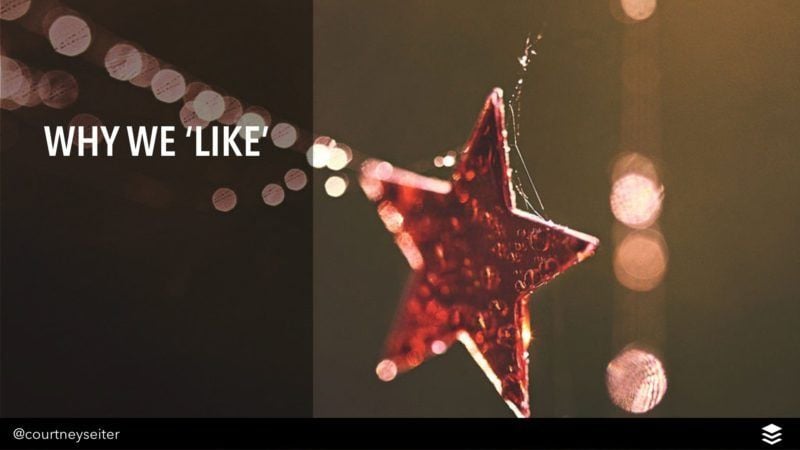
Facebook, with more than 2 billion monthly active users is a great example of a platform where people love to like. In fact, since Facebook implemented the “Like” button, it has been used more than 1.13 trillion times, with that number growing by the day.
We do this because we want to maintain relationships. When we favorite and like each other’s posts, we add value to the relationship, and reinforce that closeness.
We also create a reciprocity effect. We feel obliged to give back to people who have given to us, even in a small way. We want to even up the scales.
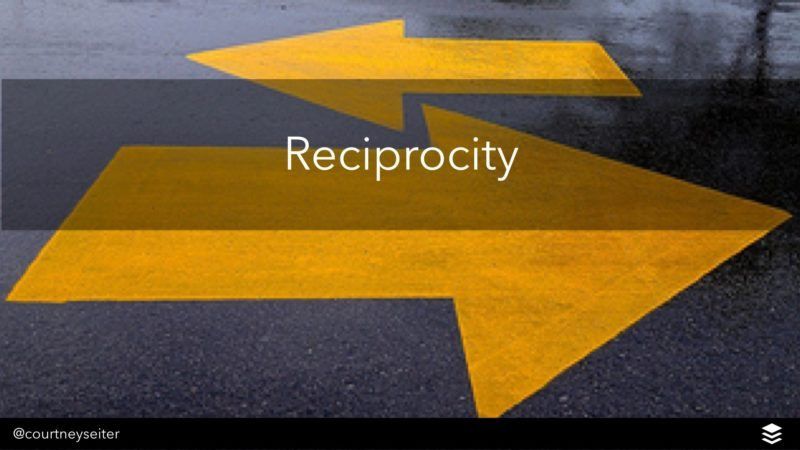
A sociologist sent Christmas cards to 600 random strangers and received 200 in return. That’s the power of reciprocity.
You see reciprocity on Instagram as well, where receiving a tag or direct message makes you feel compelled to send one back. And anytime you receive a like on your profile, you’ll probably feel a little pull to reciprocate in some way, whether it’s by sharing something in return, signing up for an email list, etc.
Why we comment
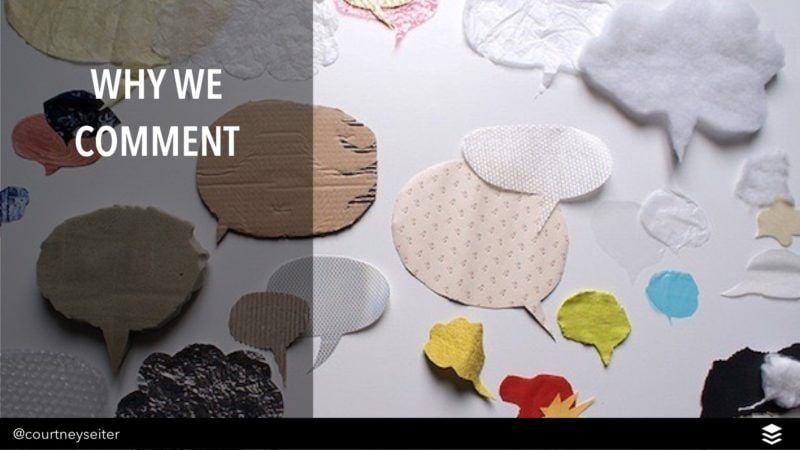
Most marketers tend to think conversations with customers are hugely important. That engagement—interacting as much as possible—is what builds long-term advocacy.
So it’s surprising to find that customers don’t feel the same way. A survey of more than 7,000 consumers found that only 23% said they have a relationship with a brand. Of those who did, only 13% cited frequent interactions with the brand as a reason for having a relationship.
Consumers said shared values were a much bigger driver for a relationship than lots of interaction with a brand.
This is not to say that comments aren’t powerful. In fact, they can be incredibly so—there’s a phenomenon known as shared reality that says our whole experience of something is affected by if and how we share it with others.
85% of us say reading other people’s responses on a topic helps us understand and process information and events.

This means comments actually have the power to change our minds, and science backs this up.
- A study on news sites showed that comments that simply attack the author, with no facts at all, are enough to change our perception of a topic.
- On the other hand, polite reviews – even when they’re negative – cause a brand to be seen as more honest and wholesome. Users were actually willing to pay about $41 more for a watch when they saw polite negative reviews than when the reviews were removed.
Basically, any comment about you, anywhere online, is to a consumer a reflection of what kind of company you are. It’s not exactly logical, but that’s how our brains work.

This means being actively engaged in the comments section of your blog and with the customer reviews of your product is crucial, not so much to the person you’re responding to but for everyone participating in the shared reality of comments and reviews.
Social media phenomena: Selfies, emoji and nostalgia
So far we’ve just scratched the surface of what’s interesting and unique about social media. Let’s dive deeper into a few intriguing phenomenon for marketers.
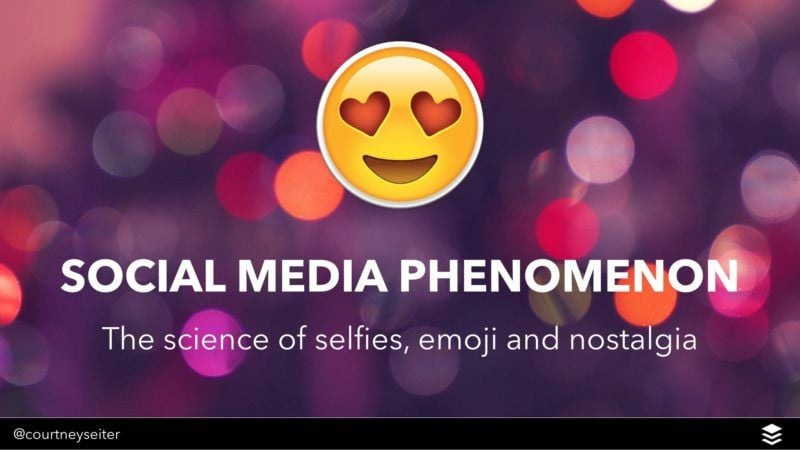
Selfie craze
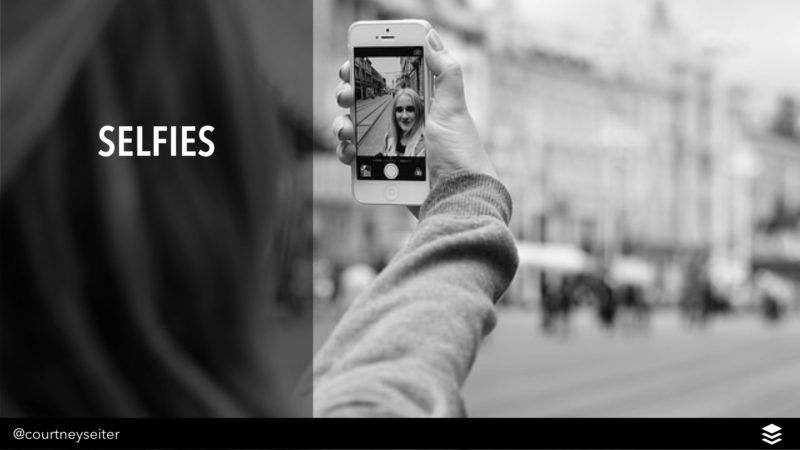
Historically, portraits have been about status, and controlling the way our image is perceived.
Today, they’re a way to figure out who we are. The “looking-glass self” is a psychological concept that says that we can never truly see ourselves—we need our reflection from others in order to understand who we are.
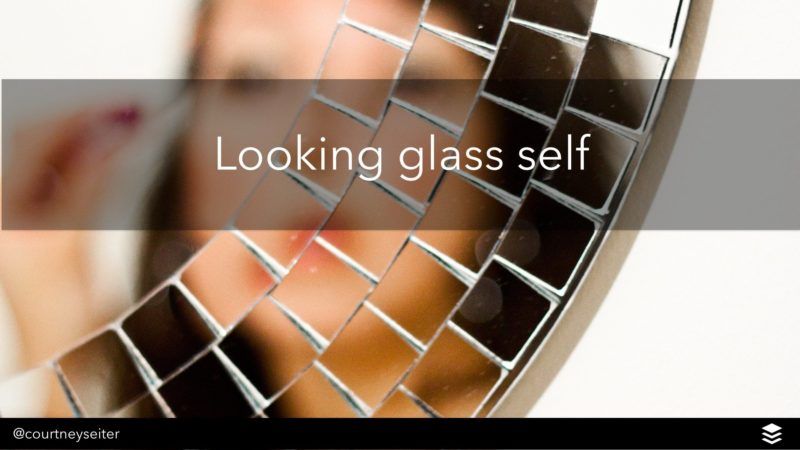
Selfies also work because we pay more attention to faces than we do to anything else.
- The profile picture is the first place the eye is drawn to on Facebook and other social media sites.
- On Instagram, pictures with human faces are 38 percent more likely to receive likes and 32 percent more likely to attract comments.
- Eye-tracking studies show that online, we follow the eyes of the people we see on screen.
Viewing faces can also create empathy. An experiment added headshots of patients into doctors’ files, and found that seeing photos of patients improved the way they treated patients.
For brands, there are many ways to harness the power of selfies—we’ve got a full breakdown here!
Power of emoji on social media

Most of us are not aware of it, but we mimic each others expressions in face-to-face conversation. This is emotional contagion, and it’s a big part of how we build connectedness.
Online, we recreate that crucial element of empathy using emoticons and emoji.
Today, 92% of people in the U.S. regularly use stickers, emoticons or emojis in their online communication, and 10 billion emoji are sent around the world every day.
The most popular emoji: ?
And there is a strong link between emoji use and social media power.
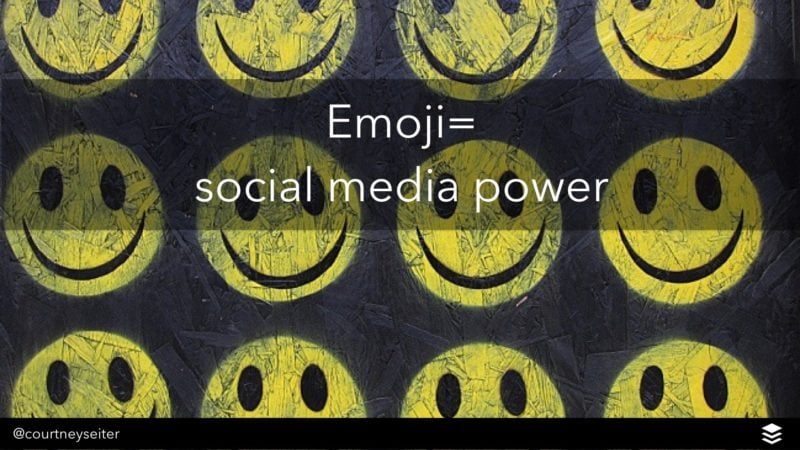
- An analysis of more than 5 years in social media found that emoji were a common factor among influential and popular social media sharers.
- And a study that had participants chat online with various types of experts found that participants rated the experts friendlier and more competent when they used emoticons in their communication.
There are plenty of fun ways to incorporate emoji into your marketing campaigns. Brands like Ikea, Coca-Cola, Burger King and Comedy Central have even created their own branded emoji for their fans to share.
Evan Wray at Swyft Media, which has worked on many of these branded emoji campaigns, says users see these in a really unique way–as self-expression, not advertising.
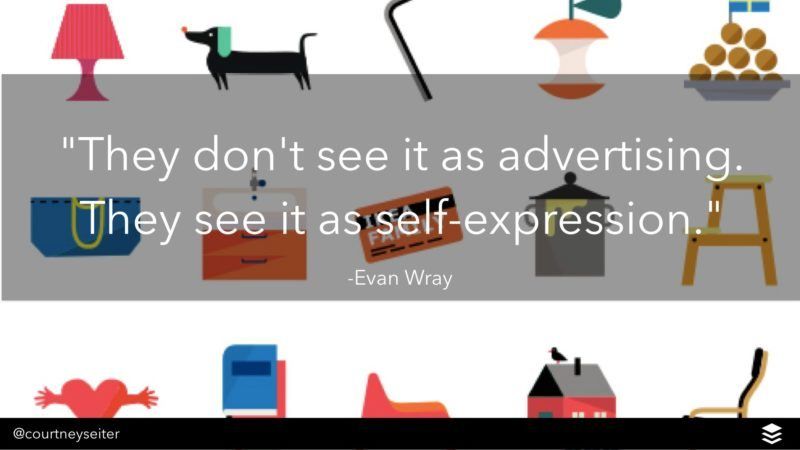
Social media nostalgia
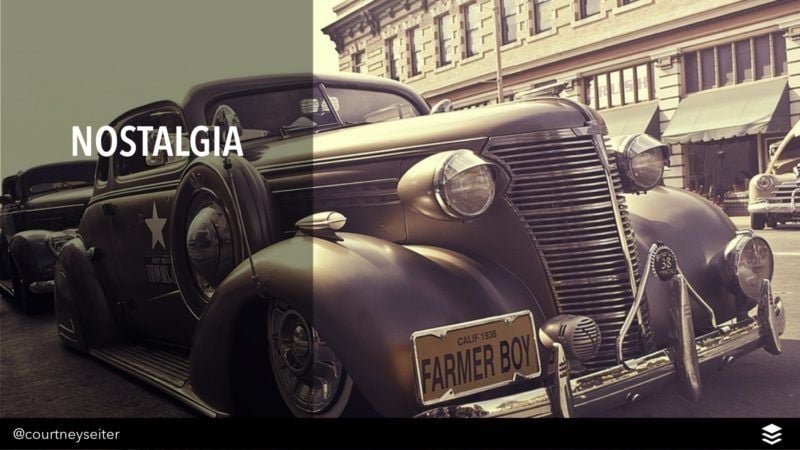
Sometimes social media—and life—moves so fast that we want things to slow down.
This is where nostalgia comes in, and this longing for the past can be an amazing strategy for modern social media marketing.
Nostalgia is universal across all cultures and it gives us a sense of social connectedness, feelings of being loved and protected.
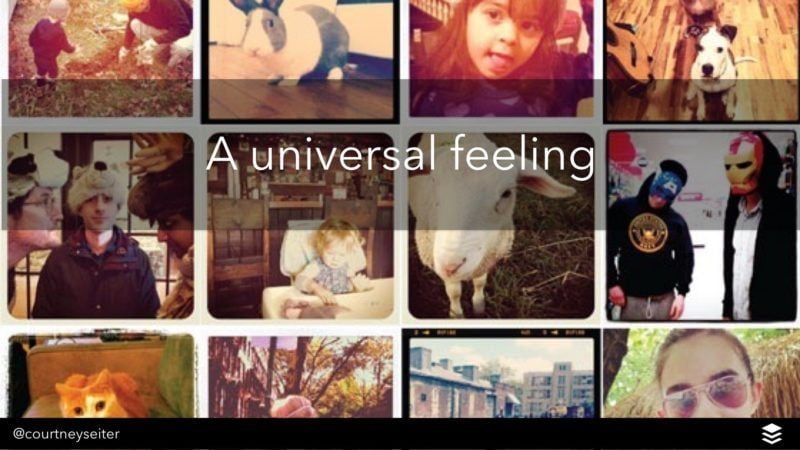
That feeling makes us think different about money. When people are asked to think about the past, they’re more likely to give money to others and they’re willing to pay more for products.
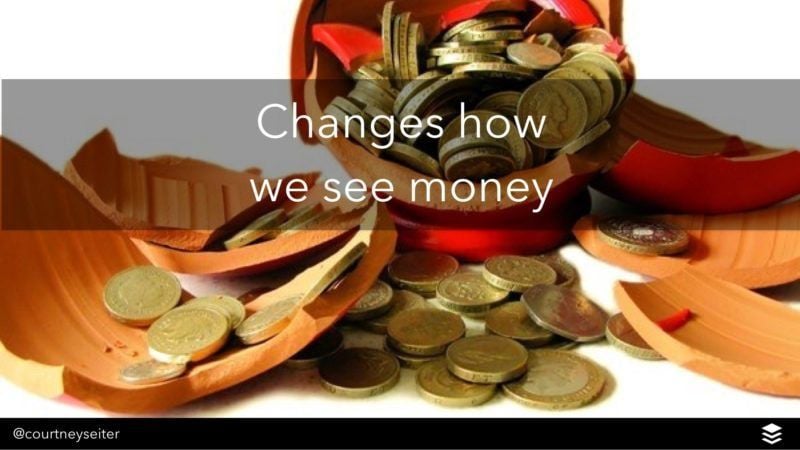
These days we’re speeding up nostalgia and creating a bigger and bigger appetite for it.
So you don’t have to have hundreds of years of history to use nostalgia in your marketing. All you need is a time period that your target market is going to feel nostalgic about.
Urban Outfitters is now selling vintage Lisa Frank stickers and notebooks from the ’80s and ’90s. (Yes, the ‘90s are vintage—that’s how fast nostalgia moves now.)
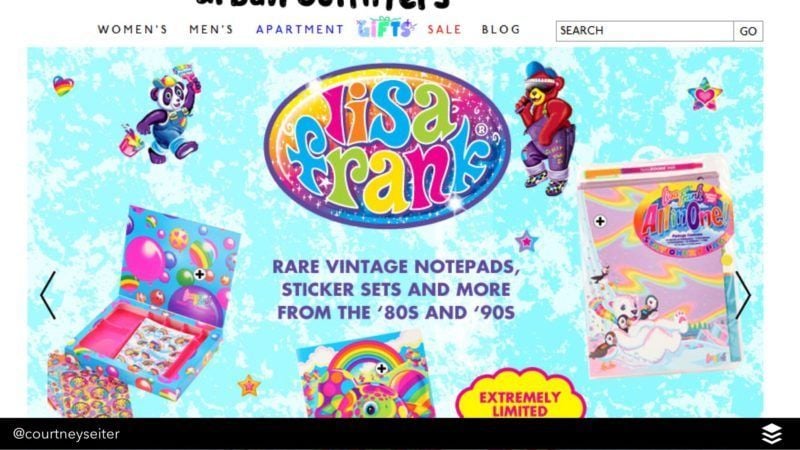
You can use Facebook insights, demographic and persona information to pick the period and then weave nostalgic references through your writing or social media posts.
Social media emoji: The dark and light sides
If we’re going to talk about the psychology of social media, we can’t ignore the studies about its negative effects. Some say it’s making us more lonely, more isolated, more depressed.
And the science behind this is very real—with the caveat that social media doesn’t change us itself; it’s just an extension of our human tendencies. It turns it up a little.
Like social comparison: we all have a tendency to assess our worth by comparing ourselves to others.

This can lead to feelings of insecurity—especially on Facebook, where we go to share our happiest, braggiest news. We’re constantly comparing ourselves against a stream of new babies, engagements, new jobs.
This isn’t just a Facebook issue; it happens on Instagram, where Instagram envy runs rampant, and on Pinterest, where a survey of 7,000 U.S. mothers revealed that 42 percent have “Pinterest stress”—they worry that they’re not crafty or creative enough.
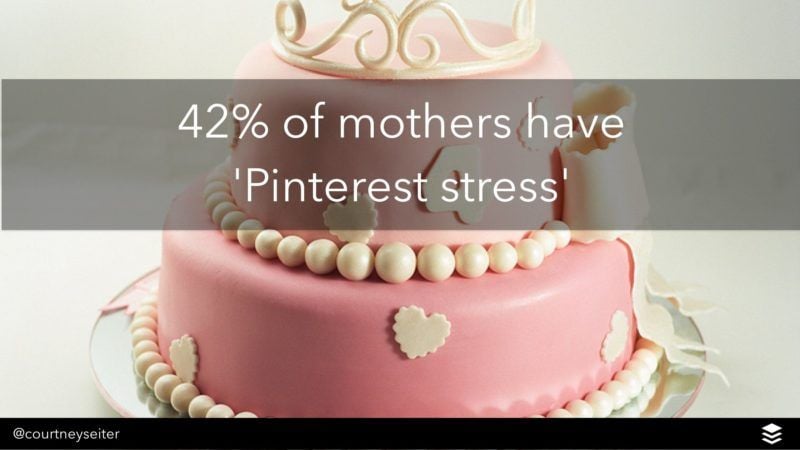
But social media can also unite us. If you’ve ever shared about a loss or a personal challenge on social media, you may have experienced the resounding support that can come from friends and even those you might not expect.
- When we’re feeling insecure, turning to Facebook offers more comfort than any other type of self-affirmation activity.
- And spending time using social networks is correlated with virtual empathy, which carries over into the real world.
Have you ever wondered why animals are so popular on social media?
An interviewer asked the Buzzfeed editors who work on these stories why animals go so viral, and they said it’s because these stories are often not really about animals at all. They often show humans at their best — rescuing, fostering, caring.
They said, “Our empathy for animals is us at our best.”

Social media can gnaw at our insecurities and suck us in, but at its core, it’s about the good in the world: seeing it in ourselves, recognizing it in others, passing it on.
It allows us to get a little closer, a little more empathetic, a little nearer to who we truly want to be. Brands have the opportunity to connect with us if they’re willing to be human along with us – with all the messiness, anxieties and joys that comes with that.
Over to you!
I really enjoyed digging into the psychology of social media for Mozcon and for you here! I’d love to hear any thoughts this brings up for you in the comments. Meanwhile, you can check out the full presentation here:
Related Articles

In this article, Nupur Mittal shares insights into four research methods that help her find content ideas and identify unique takeaways.
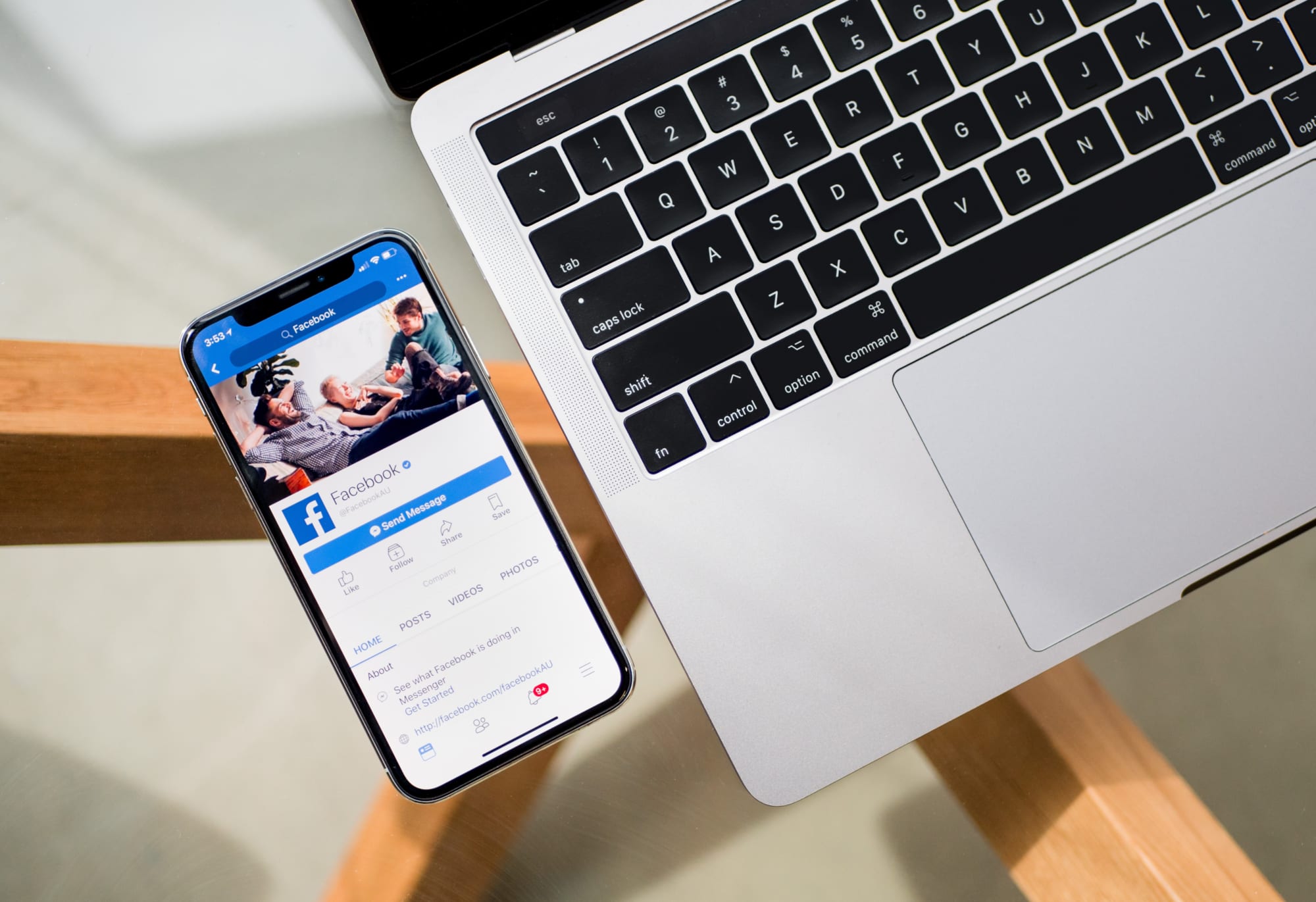
Facebook marketing in 2019 isn’t dead. On the contrary, it’s far from it. Now removed from the dim outlook that businesses faced at the beginning of 2018, Facebook has and will remain an essential tool for brands’ marketing strategies moving forward. In our big State of Social Media 2019 Report, we found that 93.7 percent of businesses use and are currently active on Facebook — the most among any other social media network. And although we continue to see a dramatic rise in the usage
